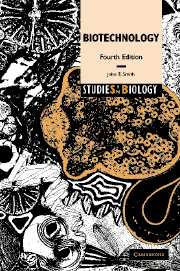Book contents
- Frontmatter
- Contents
- Preface
- 1 The nature of biotechnology
- 2 Substrates for biotechnology
- 3 Genetics and biotechnology
- 4 Bioprocess/fermentation technology
- 5 Enzyme technology
- 6 Biological fuel generation
- 7 Single cell protein (SCP)
- 8 Biotechnology and medicine
- 9 Environmental biotechnology
- 10 Biotechnology in the agricultural and forestry industries
- 11 Food and beverage biotechnology
- 12 Protection of biotechnological inventions
- 13 Safety in biotechnology
- 14 Public perception of biotechnology: genetic engineering – safety, social, moral and ethical considerations
- 15 Looking to the future
- Glossary
- Further reading
- Index
12 - Protection of biotechnological inventions
Published online by Cambridge University Press: 05 June 2012
- Frontmatter
- Contents
- Preface
- 1 The nature of biotechnology
- 2 Substrates for biotechnology
- 3 Genetics and biotechnology
- 4 Bioprocess/fermentation technology
- 5 Enzyme technology
- 6 Biological fuel generation
- 7 Single cell protein (SCP)
- 8 Biotechnology and medicine
- 9 Environmental biotechnology
- 10 Biotechnology in the agricultural and forestry industries
- 11 Food and beverage biotechnology
- 12 Protection of biotechnological inventions
- 13 Safety in biotechnology
- 14 Public perception of biotechnology: genetic engineering – safety, social, moral and ethical considerations
- 15 Looking to the future
- Glossary
- Further reading
- Index
Summary
The British National Economic Development Office has projected that the sales worldwide from new biotechnology could exceed £60 billion per annum by early this century. This will be derived from a wide range of biotechnology-based products and processes which have evolved, in most cases, from many years of expensive research and development. How can such biotechnology products and processes be protected and the due financial profits returned to the rightful inventors and industrial developers? Inventors in the area of biotechnology can be protected by way of different titles of protection, including patents for invention, plant breeders' rights and trade secrets. In the context of biotechnology inventions can be in the form of products or processes.
Products
These can be considered either as living entities of natural or artificial origin, e.g animals, plants and microorganisms, cell lines, organelles, plasmids and DNA sequences, or as naturally occurring substances – primary or secondary – derived from living systems.
Processes
These can include those of isolation, cultivation, multiplication, purification and bioconversion. Such processes can be involved in: the isolation or the creation of the above products, e.g. antibiotic production; the production of substances through bioconversion of products, e.g. enzymatic conversion of sugar to alcohol; or the use of the products for any purpose, e.g. monoclonal antibodies used for analysis or diagnosis, or microbes used for biocontrol of pathogens.
- Type
- Chapter
- Information
- Biotechnology , pp. 229 - 234Publisher: Cambridge University PressPrint publication year: 2004

